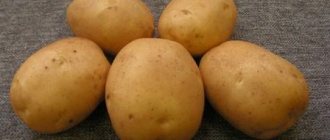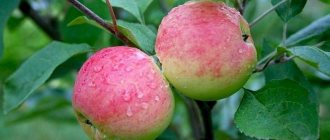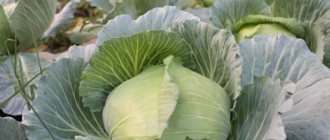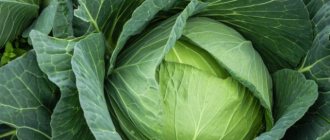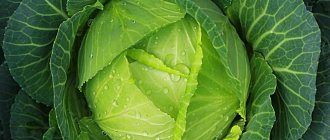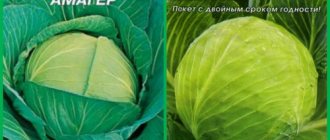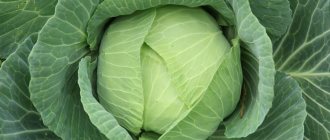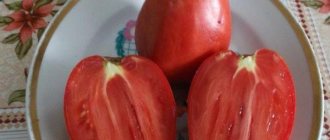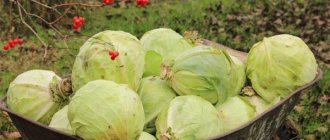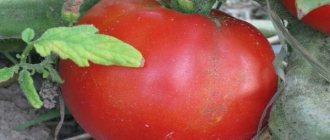Features and description of late Moscow cabbage
The late Moscow cabbage variety, which is discussed in this material, was bred in 1937 by Soviet breeders. Workers at the All-Union Research Institute of Breeding used Pyshkinskaya cabbage as a base. The Moskovskaya late variety was included in the state register of achievements in 1943, and since then it has been grown throughout Russia.
According to the description, late Moscow cabbage has a number of important characteristics:
- a spreading leaf rosette that can exceed 1 m in diameter;
- oval wrinkled leaves of a gray-green color with a waxy coating;
- long petioles and rough veins on the leaves;
Cabbage is characterized by very large heads of cabbage.
- large and dense heads of cabbage, which have a flat-round shape and a white-yellow color;
- a high outer stalk, which reaches 30 cm, and a medium inner one;
- large mass of heads of cabbage, which reaches 5 kg - in favorable conditions it reaches 15 kg;
- high yield parameters - 900 centners of cabbage can be obtained from 1 hectare;
- high yield of commercial products;
- long shelf life.
This variety has two varieties, which differ in indices 9 and 15. They have certain differences.
Moscow cabbage late 9
This variety of white cabbage is characterized by a late ripening period - about 125-140 days. The plant also boasts dense flat-round heads weighing about 8 kg. Ripe cabbage has excellent taste and universal use.
Important! This winter cabbage variety can be stored for 8 months. Heads of cabbage are not prone to cracking.
Moscow cabbage late 15
This variety is characterized by an even later ripening period, which ranges from 142-160 days. The heads of cabbage have a flat-round or round shape. On average they weigh 5 kg, but sometimes the weight increases to 15 kg.
Cabbage has excellent taste and is characterized by universal use.
The plant is characterized by high productivity. Sometimes it is possible to harvest more than 1 ton of cabbage from 1 hectare. Vegetables tolerate transportation well, are stored well and do not crack.
Reviews from gardeners about the variety
The opinions of vegetable growers about the Moscow late cabbage variety are divided. Some speak out in its defense, citing high yields and good taste, others express dissatisfaction. It is caused by the need to pay a lot of attention to caring for plants - often hilling the stems, spraying the bushes with pest control compounds. Those who grow cabbage for sale are not interested in this variety, since buyers prefer medium-sized cabbage heads, and the Moscow late one produces very large heads weighing 6 kilograms or more.
The old, time-tested variety captivates many with its excellent taste. It is valued for its juicy and dense heads of cabbage, good presentation, and the possibility of long-term storage. When growing a crop, it is important not to lose sight of its features - the need for good lighting and moisture, regular fertilizing, and hilling. By following the rules of agricultural technology, gardeners will be rewarded with a bountiful harvest.
https://youtu.be/NeWnQGUitEY
Growing technology and care
Before planting, the seed material should be soaked in warm water for half an hour. Then rinse it thoroughly in running water. It is recommended to plant seeds in a common container to a depth of 1 cm. The distance between plants should be 5-7 cm.
The room temperature should be +23 degrees. When sprouts appear, this parameter is reduced to +15..+17 degrees during the day and to +8..+10 degrees at night. This ensures full development of roots and adapts the crop to planting in open soil.
Planting seedlings in the ground
The area for cabbage needs to be prepared in the fall. At this stage, it is recommended to add organic matter and minerals. It is important to choose a sunny area for the plant with a predominance of slightly acidic or neutral loamy soil. Acidic soil is not suitable for cabbage.
Attention! The plant is prohibited from being planted in beds where crops from the Cruciferous family previously grew.
Seedlings must be planted in dug up soil, maintaining an interval of 80 cm. This distance must also be left between the rows. After completing the planting work, the beds must be thoroughly watered.
After planting seedlings in open ground, the bushes need to be well watered.
Watering and fertilizing
The plant needs regular but moderate watering. Excessive soil moisture leads to the development of root rot. The beds need to be watered once a week. In this case, it is necessary to use 3 liters of water per bush.
During the growing season, plants need to be fed twice:
- 25 days after planting the crop in open ground. At this stage, organic products are used. It is best to use humus or a solution of bird droppings.
- At the stage of fruit formation. At this time, cabbage needs potassium and nitrogen.
Loosening and hilling the soil
After each watering, the soil must be loosened. This provides the roots with the maximum amount of oxygen and nutrients. To reduce the amount of loosening, the bed should be covered with a mulching layer of straw, hay or sawdust.
Attention! Cabbage has a tall stalk that may not support the weight of the head. Therefore, during the season you should rake the soil to the heads of cabbage 3 times.
The first time the procedure is carried out after planting the seedlings. Then you need to control the growth rate of the stalk. When the head of cabbage rises a few centimeters above the ground, it needs to be hilled up.
Advantages and disadvantages of the Moscow late variety
Main advantages:
- high productivity;
- density, juiciness, universal use of heads of cabbage;
- high sugar and vitamin C content;
- uniform ripening of the crop;
- resistance to keeling and cracking;
- good keeping quality and transportability;
- high yield of marketable products;
- frost resistance.
The disadvantages include a high stalk, which may not support the weight of the head of cabbage. Because of this, cabbage is hilled high or supports are used.
Difference from other varieties and hybrids
Comparison of Moscow late with other late-ripening cabbage varieties in the table.
| Variety | Head shape | Head weight, kg | Average yield, c/ha |
| Moscow late | Round-flat | 5-8 | 602-885 |
| Kharkov winter | 3,5-4,2 | 583-832 | |
| Wintering 1474 | 2-3,6 | 450-523 | |
| Aggressor | Round | Up to 5 | 431-650 |
Pest and disease control
The plant is resistant to common pathologies. It is not even affected by clubroot, which affects most cabbage varieties. In this case, the crop may encounter various pests:
- Fleas. To cope with parasites, the bushes should be sprayed with a solution of potassium permanganate. It is recommended to take 20 mg of the product per 10 liters of warm water.
- Butterflies. Bordeaux mixture will help eliminate these pests. It is recommended to take 10 mg of the product per 10 liters of water. Bushes should be sprayed every 10 days. This is done until the parasites are completely destroyed.
- Aphid. Copper-based preparations help control aphids. These include Epin and Oksikhom. It is recommended to take at least 30 mg of the product per 5 liters of water. Colloidal salt will also help control aphids. It is recommended to take 50 g of the substance per 10 liters of water. The solution should be applied every 2 weeks.
Slugs can cause great damage to cabbage plantings if they appear on the site. They need to be collected manually or traps set.
Landing
Cabbage seedlings are sown in late March or early April. To protect against fungi and strengthen plants, the seeds are hardened (placed in hot water at a temperature of +50 degrees, and after half an hour transferred to cold water for 3 minutes), then pickled in a solution of 1% potassium permanganate.
Sow in nutritious light soil to a depth of 0.5-1 cm, lightly moisten. Place in a warm place at +20-24 degrees. When sprouts appear, reduce the temperature to +14-17. When grown in common boxes, they are picked in the phase of 1-2 leaves; in individual containers, the bushes are thinned out.
They are planted in the garden 35-45 days after germination. A distance of at least 70 cm is left between the bushes.
You cannot plant seedlings in areas after cabbage, radishes or radishes.
Harvest and storage
It is recommended to harvest cabbage at one time - after the first frost. The heads of cabbage should be carefully cut with a sharp knife and folded, being careful not to damage the top leaves. It is recommended to pull out the tops by the roots and remove them away from the site.
With proper care, Moscow cabbage produces a bountiful harvest.
Important! The harvest is best kept in a cool place. In this case, the room should have a positive temperature and low humidity.
Late Moscow cabbage variety has many advantages. That is why it is grown by gardeners throughout the country and abroad. To get a bountiful harvest, you need to strictly implement agrotechnical measures.
Real reviews
Previously, late Moscow cabbage was very popular, and reviews about it were only positive. But recently, many gardeners are abandoning this variety in favor of other hybrids and varieties. This is primarily due to cultural deficiencies. However, there are many adherents of the variety who leave positive reviews online.
My great-grandmother also grew Moscow late cabbage. It ripens in our region at the end of October and is stored wonderfully all winter. Very tasty when fermented. Tender, sweet, suitable for making kryzhalka. Therefore, every year I also plant this variety little by little.
The best varieties
Among the variety of red cabbage varieties, the best ones are distinguished in terms of the ratio of their main characteristics. Almost all of them are late- or mid-ripening.
Calibos
This is a mid-season cabbage variety that is cultivated throughout Russia. It takes 140-150 days for the seedlings to form heads. It is suitable for both fermentation and fresh consumption. The fork has a characteristic triangular shape - cone-shaped, its weight does not exceed 2 kg. The average yield is 6 kg/sq. m.
The leaves are red, slightly bubbly. When cut, the head of cabbage has a rich red-violet color. The plant boasts excellent taste, juicy and delicate structure. Many vegetable growers consider this variety of red cabbage to be the most delicious.
However, such a delicate structure also has many disadvantages:
- Mechanized harvesting is not suitable for Kalibos. When collecting by hand, care must be taken not to damage the thin leaves.
- This variety is also not suitable for long-term storage. Even if you create optimal storage conditions for cabbage, it will last until December at most.
- The variety is demanding on soil moisture and cool weather conditions, but on the other hand, thanks to this, it tolerates low temperatures and is classified as a cold-resistant crop.
Stone head 447
An ancient variety that was included in the State Register of the Russian Federation back in 1943. It is intended for cultivation throughout the country without exception, and is classified as a mid-season variety. Despite the fact that the variety has a number of disadvantages, vegetable growers continue to plant it on their plots for several decades.
The plant will need 105-135 days to reach the technical maturity of the heads of cabbage, from the emergence of seedlings. Productivity is low - 2.5-5 kg/sq. m. The fork is rounded, dense, but not resistant to cracking. The leaf blade is slightly wrinkled or smooth. It is colored red-violet and covered with a small layer of waxy coating.
Pallet
A late-ripening variety that requires about 150 days from emergence to mature to technical ripeness. The yield is average, 5-6 kg are harvested per square meter. m. The heads of cabbage are round, violet-red in color with a maximum weight of 1.8 kg.
The variety is resistant to temperature fluctuations and is not afraid of the vagaries of the weather. Its leaves are sparse. The shelf life does not exceed 4 months.
Nurima F1
A hybrid from Dutch breeders, who position it as the earliest ripening - the plant needs only 70-80 days to ripen. Yields are average; about 6 kg are harvested per square meter. m. The fork has an absolutely round shape, medium size and purple color. Its weight does not exceed 2 kg.
The rosette is compact, which allows you to easily cover it with covering material if necessary. The variety is immune to diseases and does not suffer from temperature fluctuations. Cabbage is suitable for short-term storage.
Plant seedlings in sunny places
Late Moscow cabbage:
- About the variety. White cabbage Moscow late 15 (lat. Brassica oleracea var. capitata) is an ancient product of Moscow breeders. Perfect for home and industrial cultivation. The period from germination to technical ripeness is 115 - 140 days. The foliage is dark green, the cabbage is white when cut. Heads of cabbage reach large sizes and weight up to 15 kg. Stores well and is suitable for preparing various dishes.
- Landing. Due to its large size and spreading rosette, it requires a large growing area. The recommended planting pattern is 70x80 or 80x80 cm. Loves rich, moist soils and is responsive to organic fertilizing.
- Care. The variety is resistant to pests and various bacterial diseases. It is not afraid of low temperatures and does not require maintenance. Due to the high stump and large size, it can fall on its side, so high hilling is required during the growth process.
Video: The Federal Scientific Center for Vegetable Growing offers excellent seed material and recommends cabbage for consumption.
Secrets of productivity
To successfully grow late-ripening white cabbage, it is necessary to carry out proper and regular care of the vegetable crop.
| Irrigation activities | Particularly abundant watering is needed during dry periods. Watering is carried out at the root, in the evening hours. During the final period of ripening, watering should be reduced so that the heads of cabbage do not crack. |
| Fertilizer application | The first feeding is carried out three weeks after planting, and the second and third - no earlier than 12 and 24 days after the first. It is recommended to use diluted bird droppings or slurry. Plants respond well to mulching with humus or compost. |
Cabbage beds should be regularly cleared of weeds, and after watering and rain, shallow loosening and hilling of the vegetable crop should be carried out.
To protect against diseases and pests, you can use modern insectofungicides or use folk remedies, including wood ash, dolomite flour, as well as decoctions or infusions of tomato tops, garlic, wormwood and onions.
Optimal planting dates
With the exception of the southern regions, the late-ripening cabbage variety, to which Moskovskaya late belongs, is grown using seedlings. And since by the time the seedlings should be planted in open ground, they should be about 40 days old, which means that the seeds must be planted in the ground from late March to mid-April, depending on the climatic conditions of the region. Experts recommend that by the time of planting in open ground, the seedlings should have a height of about 0.2 m and up to 6 true leaves on the stem.
